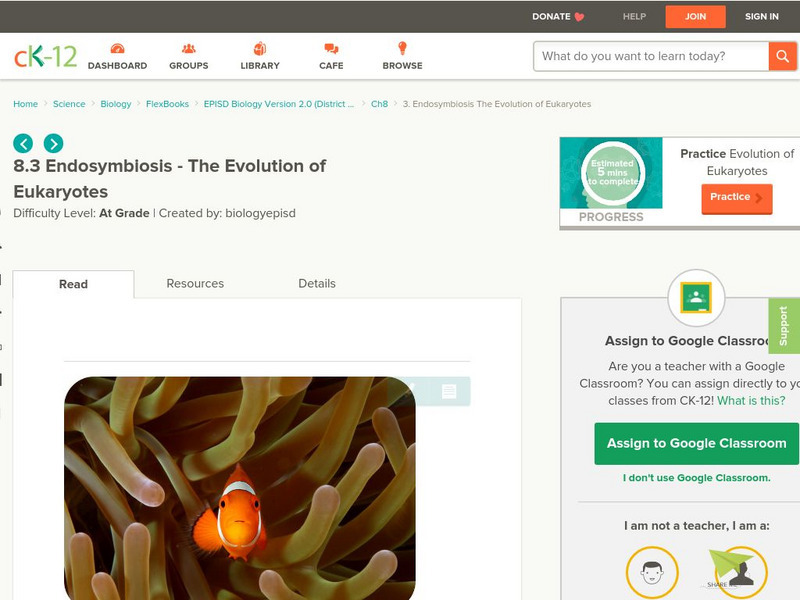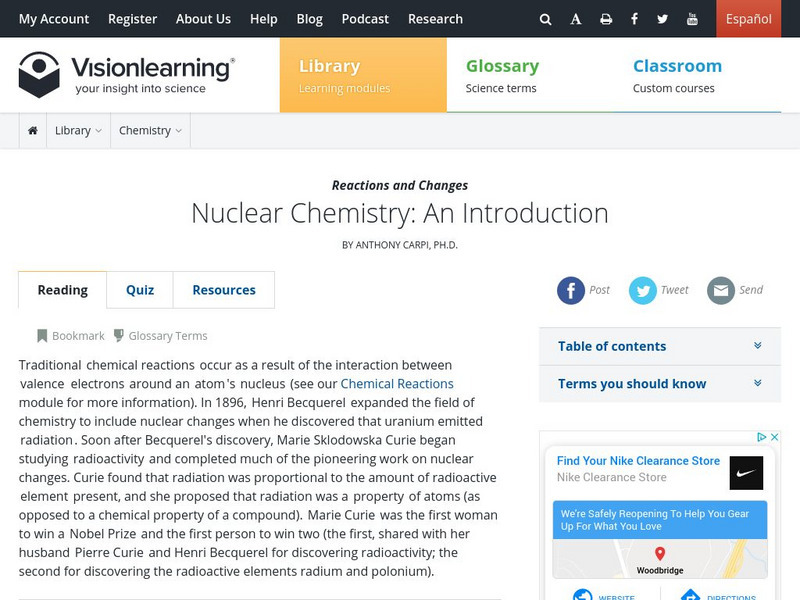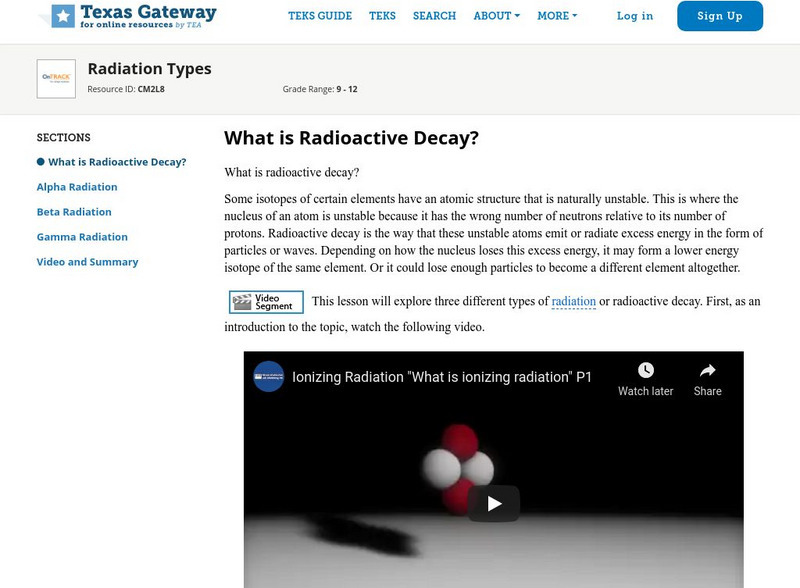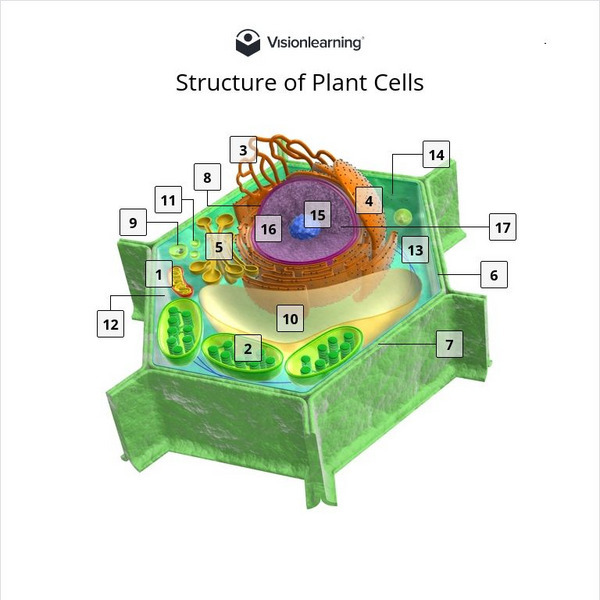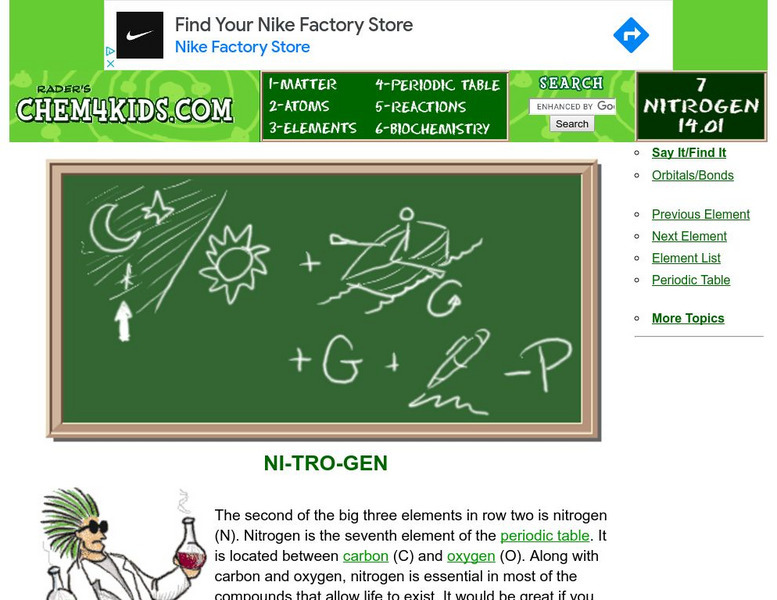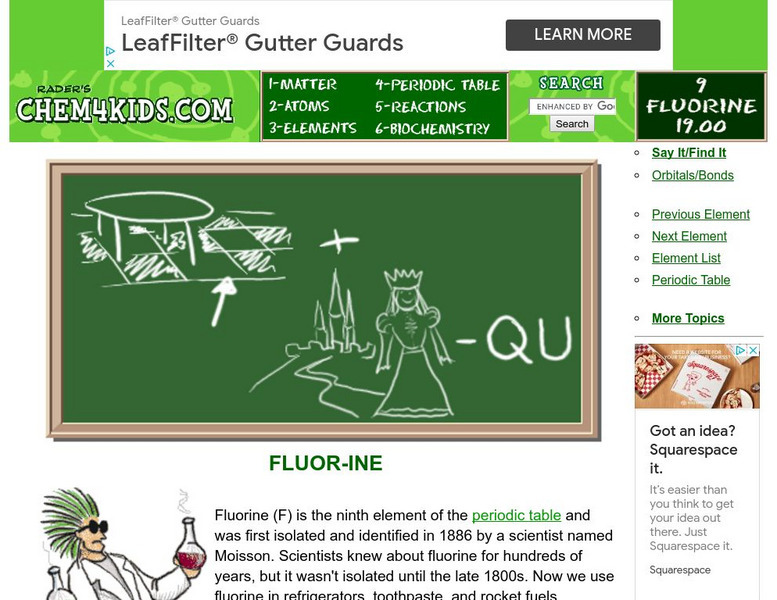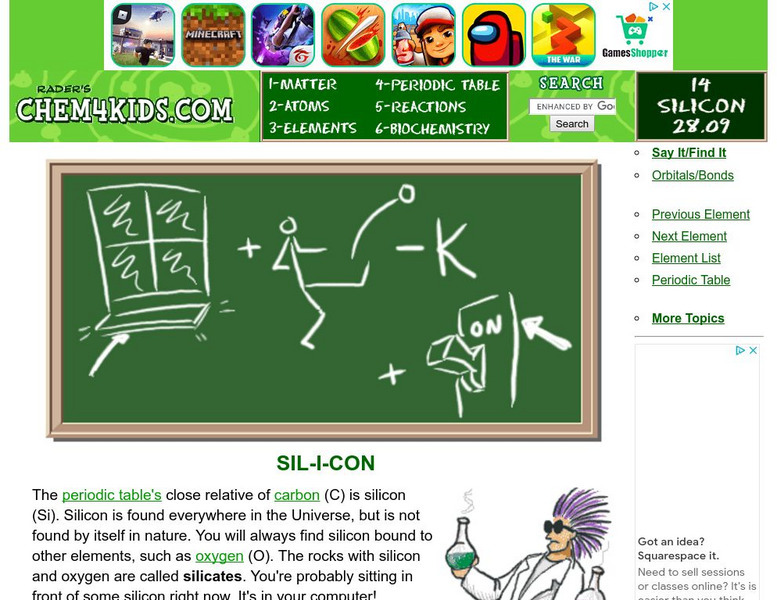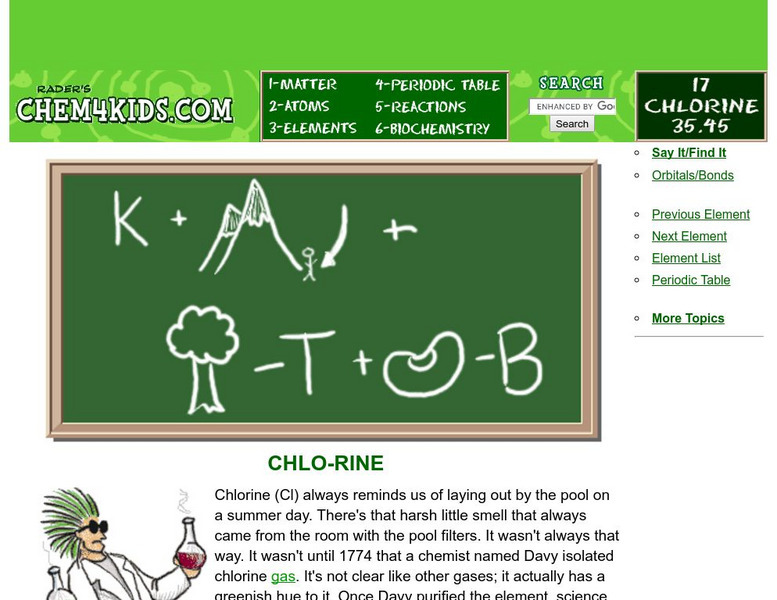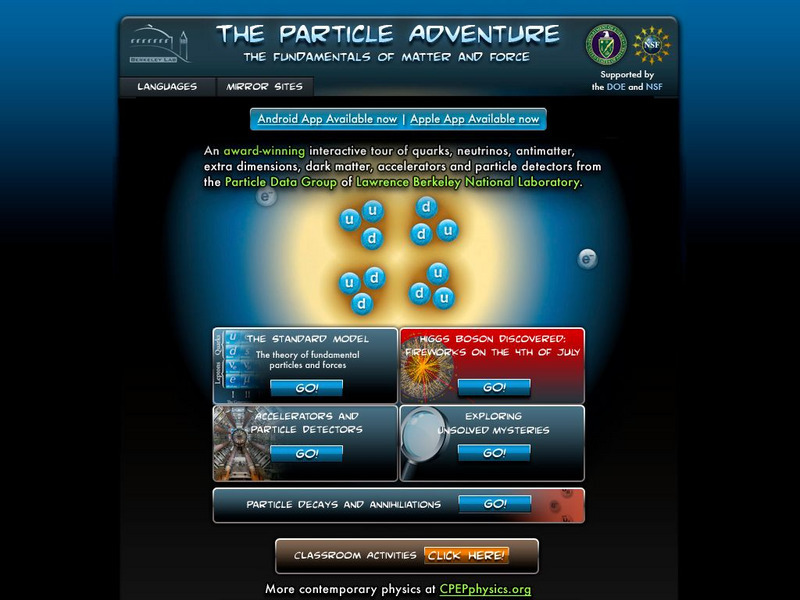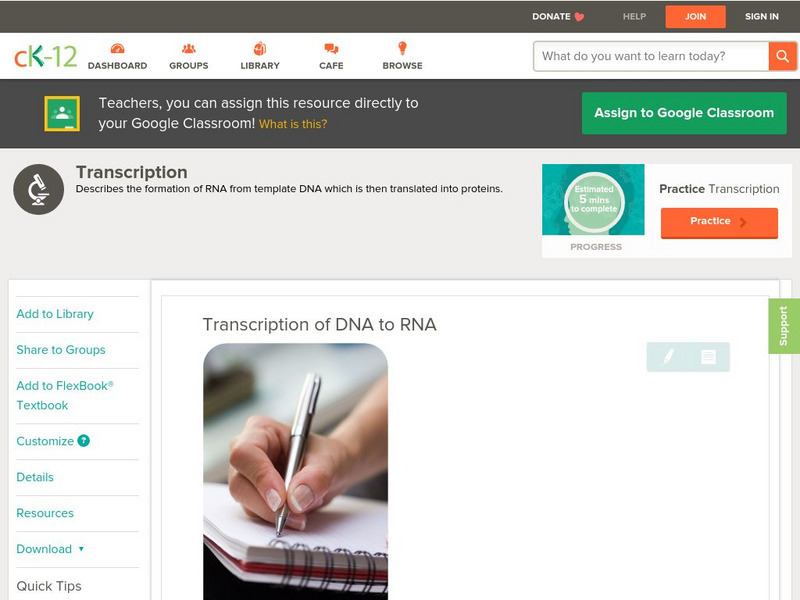CK-12 Foundation
Ck 12: Endosymbiosis the Evolution of Eukaryotes
[Free Registration/Login may be required to access all resource tools.] Learn about the evolution of eukaryotes which is explained by the endosymbiotic theory.
Untamed Science
Untamed Science: Biology: Cell Biology
Make learning about cells fun and easy with a collection of short video clips about cellular biology. Find out about the structure and function of the main organelles inside an animal cell.
Vision Learning
Vision Learning: Nuclear Fusion
Interactive concept simulation demonstrates the nuclear fusion of deuterium and tritium inside a tokamak reactor.
Texas Education Agency
Texas Gateway: Radiation Types
Given illustrations, diagrams, or descriptions, students will identify alpha, beta, or gamma radiation.
Vision Learning
Visionlearning: Structure of Plant Cells
An interactive plant cell that presents labels and definitions of the different cell parts when selected.
Chem4kids
Chem4 Kids: Carbon
Click on the left navigation terms for some great information about the 6th element in the periodic table, "carbon." Content focuses on carbon's electrons, where you can find carbon in nature and in the home, and how carbon combines with...
Chem4kids
Chem4 Kids: Nitrogen (N)
Here you can find some great information about the 7th element in the periodic table, "nitrogen." Content focuses on nitrogen's electrons, where you can find nitrogen in nature and in the home, and how nitrogen combines with other elements.
Chem4kids
Chem4 Kids: Fluorine
Here you can find some great information about the 9th element in the periodic table, "fluorine." Content focuses on fluorine's electrons, where you can find fluorine in nature and in the home, and how fluorine combines with other elements.
Chem4kids
Chem4 Kids: Neon (Ne)
Here you can find some great information about the 10th element in the periodic table, "neon." Content focuses on neon's electrons, where you can find neon in nature and in the home, and how neon combines with other elements.
Chem4kids
Chem4 Kids: Magnesium (Mg)
Here you can find some great information about the 12th element in the periodic table, "magnesium." Content focuses on magnesium's electrons, where you can find magnesium in nature and in the home, and how magnesium combines with other...
Chem4kids
Chem4 Kids: Silicon (Si)
Here you can find some great information about the 14th element in the periodic table, "silicon." Content focuses on silicon's electrons, where you can find silicon in nature and in the home, and how silicon combines with other elements.
Chem4kids
Chem4 Kids: Phosphorus (P)
Here you can find some great information about the 15th element in the periodic table, "phosphorus." Content focuses on phosphorus' electrons, where you can find phosphorus in nature and in the home, and how phosphorus combines with...
Chem4kids
Chem4 Kids: Chlorine (Cl)
The 17th element in the periodic table is defined, chlorine. Find out how many electrons chlorine has and where you can find it in nature and in the home.
Chem4kids
Chem4 Kids: Argon (Ar)
Chem4Kids looks at the 18th element in the periodic table, argon. Content focuses on argon's electrons, where you can find argon in nature and in the home, and how argon combines with other elements.
Other
University of Leicester: Spiral Galaxies
Provides a general overview of spiral galaxies, including descriptions of the different classes of spiral galaxy.
PBS
Nova: Atom Builder
Find out if you know enough about atoms to build them. The goal of the activity is to build an atom of a particular element by dragging the correct numbers of neutrons, protons and electrons into the atom.
PBS
Pbs Learning Media: Journey Into Dna
Travel deep into the human body to see exactly where your DNA resides. From the NOVA: Cracking the Code of Life Web site.
PBS
Pbs Learning Media: How Cancer Cells Grow and Divide
This animation from NOVA: "Battle in the War on Cancer: Breast Cancer" describes how oncogenes cause cancer and how cancerous cells can spread throughout the body.
American Chemical Society
Middle School Chemistry: Protons, Neutrons, and Electrons
Investigate why a charged object is attracted or repelled by another charged object. Explore the concept that the attraction between positive protons and negative electrons holds an atom together.
American Chemical Society
Middle School Chemistry: Energy Levels, Electrons, and Covalent Bonding
Students discover the concept that two atoms can attract and form a covalent bond.
Lawrence Berkeley National Laboratory
Berkeley Lab: The Particle Adventure
Visit this site for an interactive tour of the atom and all aspects of particle physics. View the animations available with almost every description on this site. A great place for the fundamentals of particles and forces including a...
PBS
Pbs Learning Media: Atomic Structure
Take a look at the parts of an atom and learn about its properties.
CK-12 Foundation
Ck 12: Life Science: Transcription of Dna to Rna
[Free Registration/Login may be required to access all resource tools.] DNA is located in the nucleus. Proteins are made on ribosomes in the cytoplasm. Remember that information in a gene is converted into mRNA, which carries the...
CK-12 Foundation
Ck 12: Life Science: Rna
[Free Registration/Login may be required to access all resource tools.] DNA contains the instructions to create proteins, but it does not make proteins itself. DNA is located in the nucleus, which it never leaves, while proteins are made...
Other popular searches
- Cell Nucleus
- Atomic Nucleus
- Comet Nucleus
- Nucleus Dna Replication
- Nucleus of Cells
- The Nucleus
- Nucleus Radioactivity
- Condensation Nucleus
- Nucleus Discovery
- Chromatin Nucleus
- Nucleus and Human Body
- Nucleus Partners
